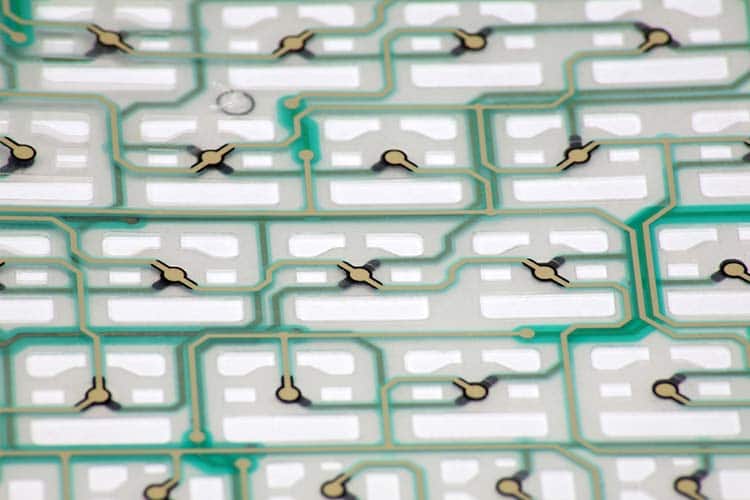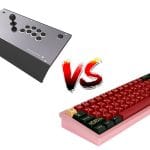Membrane keyboards are the successor to the old mechanical keyboards first released in 1985. The main difference between membrane and mechanical keys is their actuation mechanism.
Compared to mechanical keyboards, membrane keyboards rely on two membrane layers with conductive traces. The keyboard input largely depends on which part of the membrane is detected. The whole process is simplified compared to mechanical keyboards with individual switches under each key.
Because membrane keyboards use a more simplified actuation mechanism, they tend to be cheaper more affordable for both the consumer and the manufacturer. Also, their lightweight and relatively quiet sound make them popular options for academic and professional use where keyboards are often used in places where the sound of a mechanical keyboard would not be tolerated, such as libraries and offices. However, given their price point, are membrane keyboards truly reliable tools?
To answer this question, let us look at how membrane keyboards work in more detail. Additionally, we’ll discuss some of the shortcomings of membrane keyboards in the sections below.
What are Membrane Keyboards

Before we talk about how they work, let us briefly discuss membrane keyboards. As we have mentioned earlier, membrane keyboards are more lightweight versions of the older mechanical keyboards, and they have a simpler structure and often use lower-quality components.
However, not all membrane keyboards are built the same. Some try to mimic how mechanical keyboards work, while others introduce a completely different feel. In other words, not all membrane keyboards are meant to be inferior to the original mechanical keyboards. Additionally, membrane keyboards are incredibly useful for those who wish to carry around their keyboards or for those who wish to work in quiet environments.
Why are Membrane Keyboards Usually Not Recommended

When talking about general consumer-grade membrane keyboards, most of them have issues with durability. Since there are no individual key switches, if one key breaks, then the rest are likely to follow.
Also, speaking of keys, membrane keyboards cannot accept multiple key inputs. Most membrane keyboards struggle when pressing more than five keys, depending on the manufacturer. And when playing video games, most membrane keyboards can potentially register keys that you didn’t press whenever you try to press too many buttons. This phenomenon is called ghosting.
And, of course, unlike mechanical keyboards, most membrane keyboards lack that tactile and satisfying feel of mechanical keyboards. Most keys are hard to press, which leads to more typos.
Lastly, most membrane keyboards have subpar aesthetics. Since almost everybody is working at home, style and aesthetics have a big role when choosing keyboards.
Membrane keyboards are not very customizable if you want to change the aesthetics or feel of your keys, from the keycaps to changing how your keyboard feels when typing.
Membrane Keyboard Switch Actuation/Mechanism

There are two thin membrane layers with conductive traces, and in the middle, there’s a spacer where keys are located. Rubber or silicone material is applied to contact pads and the keycaps.
When the key is pressed, the current cannot cross to the lower layer, but the conductive trace can cross the lower layer when the upper layer is pressed.
When a key is released, it registers as a keystroke, and the controller sends each keystroke it registers to the central processor.
Why Membrane Keyboards are Less Accurate
Membrane keyboards are infamous for being hard to press because contact with the membrane layer is not easily achieved. Therefore, you usually have to press harder for a key to register.
Mechanical keyboards, on the other hand, are a lot more accurate. Depending on the switch used, you may not have to bottom out the key to actuate the switch.
Are Membrane Keyboards Less Durable?

Aside from the issue with the durability of the keys, membrane keyboards also have other issues with the durability of their build quality. Most generic membrane keyboards have a fixed cable, meaning they are not easily replaceable when they break. You would have to open up the keyboard and solder a new USB cable.
Additionally, the plastic used for the housing is not the highest quality. These keyboards can often break in intense situations such as gaming, and even dropping them while carrying them around will usually break them.
Of course, this does not apply to all membrane keyboards. But generally, membrane keyboards are treated as disposable goods that are meant to be easily replaced whenever they break.

The KBE team is dedicated to sharing our knowledge and creating useful resources about computer keyboards. This article was written as a team collaboration, combining our knowledge and years of experience using, building and modding keyboards. Meet the team here.




